In honor of Jim Wofford’s annual Rolex Kentucky Three-Day Event rider critique in Practical Horseman magazine, the editors dug through the archives and found this article from the 1978 World Championships, which would later become what is now known as Rolex. In this article, legendary team coach Jack Le Goff critiqued several riders, including Jim on Carawich at the Head of the Lake, in the article that appears in the July 2013 issue. Here are more critiques that did not make it into the reprint.
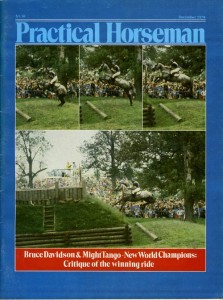
Park Pavilion
Fences 3 and 4 consisted of two elements, each 3-foot-11 high. The most direct route, through the middle, included two 4-foot deep benches against the inside walls with room for only one long stride between. Most riders elected one of the diagonal routes bypassing the benches and leaving themselves the option of adding another stride should the horse falter in jumping from bright sunlight to shade. The first element (3) eliminated Argentina’s Alberto Gonzalez and Arpegio. Carlos Rawson and Kielin, also of Argentina, had a refusal and fall, as did Joanne Bridgeman of New Zealand and Bandolier. Argentina’s Pedro Mercado and Cafayate had a refusal. The second element produced no penalties.
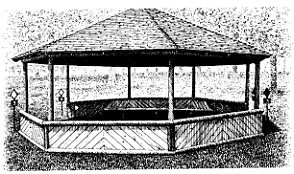 Park Pavilion
Park PavilionHead of the Lake
Fence 17AB was a 4-foot-11 spread over water onto a bank, birch rails 2-foot-8 high and a drop of 5-foot-11 into the water. Head of the Lake took its toll. Eddy Stibbe and Autumn Haze of the Netherlands were eliminated here. Jane Holderness-Roddam of Great Britain accumulated 140 penalty points when Warrior had one refusal and two falls. Otto Ammerman and Volturno of Germany and Kuaranjo Saito and Polly Ladd of Japan had refusals. Canada’s Martha Anne Shires and Belfast Road and the Netherlands’ Alicie Waanders and Regal Abbot had falls.
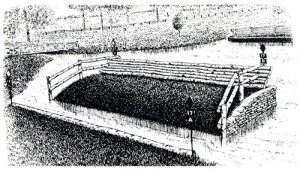 Head of the Lake
Head of the LakeThe Kennels
Fence 11ABC was three elements varying in height from 3-foot-9 to 4-foot-3. Le Goff advised the Americans to take the direct route over the double bounce at the far left or riders could eliminate the second bounce by jumping in at the left end and swinging in a dogleg path around the one partial barrier and out. Tad Coffin fell with Bally Cor. Mary Anne Tauskey had a refusal at the second element, turned right abruptly and took the alternate route out. The Netherlands’ Autumn Haze and Argentina’s Cafayate also had refusals.
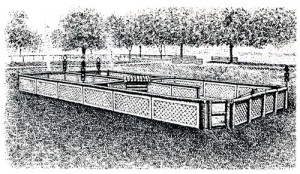 The Kennels
The KennelsGo to the next page to read Jack Le Goff’s critique of Story Jenks riding Toughkenamon at the Ditch and Brush.
Ditch and Brush
Obstacle 17 was 3-feet-11 high on the right, 4-feet-7 on the left. The Americans opted for the approach from the left that included a ditch 8-feet-8 wide. The approach to the right was through water with room on the bank for only a bounce. The single casualty was a fall by Canada’s Cathy Wedge and Abracadabra.
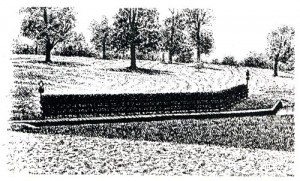 Ditch and Brush
Ditch and BrushStory Jenks and Toughkenamon
The left side of this obstacle, which Story is jumping, is like a steeplechase fence and should have been ridden at steeplechase speed, about 700 meters per minute. You were coming down a hill and could use some of that momentum to carry you over. As long as your horse still had a little gas in the tank, it wasn’t much harder for him to take this route, and it saved a lot of time.
The other way, you had to slow down to a trot, splash through the water, climb the bank and bounce over the fence, two efforts and you lose your rhythm.
A tired horse would have to take the slower speed to the right. Even if he could give you the speed, coming down the hill you might discover that his stride was all he had. There might have been no spring left in him.
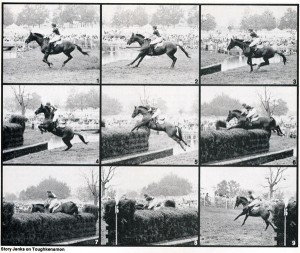 Click to view larger images | ? Karl Leck
Click to view larger images | ? Karl LeckI’d like to see Story’s horse balanced a little more naturally in Frame 1. He’s too much on his haunches and too high in his forehand. There must be a problem, but to appreciate it, you would have to be on the horse looking at the fence.
In Frame 2, he looks much better, but in Frame 3, he’s sucking back, losing impulsion. Story is giving him plenty of rein and keeping his legs on, but the horse checks himself. He wants to have another look. He says, “Hey that ditch is wide.” Then, in Frame 4, he says, “But I’m going.”
It was more of an effort than it should have been because he lost his momentum when he hesitated. He didn’t flow just right.
But Story is with the horse. He’s sending his heart to the other side of the fence, and that’s what had to be done. If he’d taken a back seat here, he’d have slowed down the trajectory and they might not have cleared the fence.
Go to the next page to read the critique of Tad Coffin and Bally Cor at the Giant’s Table.
Giant’s Table
Fence 10 was 3-feet-3 high, 6-feet-7 wide. It could be banked. Riders had to pick their routes between staggered chairs. Most elected to take the left-hand gap, which provided the shortest route to the next fence. All competitors went clean at this obstacle.
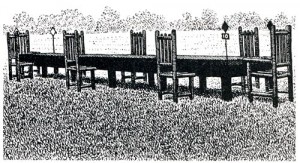 Giant’s Table
Giant’s TableTad Coffin and Bally Cor
This was a maximum width fence. There was only one way to jump it. You just had to gallop at it with enough speed and momentum that the horse could clear the distance. At the same time you didn’t want to stand back at a very wide fence like this because it adds to the spread.
All you could do in the approach was to stay quiet or, if you saw you were going to meet it too far off, lengthen your stride. If you tried to shorten your horse’s stride, you lost the momentum you needed to carry you over.
I’m sure some horses banked this fence. That was perfectly safe with a clever horse. But there was no reason to plan to bank it. You should have ridden the approach preparing to fly it but if, for one reason or another, the horse wanted to bank it, that was fine, too.
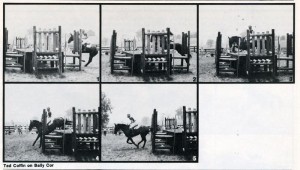 Click to view larger image. | ? Karl Leck
Click to view larger image. | ? Karl LeckTad’s mare seems to have met the fence right. Her takeoff looks good. In Frame 3, I think Tad is realizing that he’s not going to land very far out from the fence. In fact, he might think the mare is going to bank it and he’s taken a conservative seat.
Go to the next page to read about Mike Huber and Gold Chip’s turn at the Footbridge.
Footbridge
Fence 21 had an option of 3-feet-11 on the left or 3-feet-7 on the right. The Americans were advised to take the right side because of the difficulty of jumping the extra height out of the water. Mike Plumb had two refusals on the right, clearing the left on his third try. Herbert Blocker and Albrant of Germany and Saito of Japan also had refusals. Mary Anne Shires retired Belfast Road.
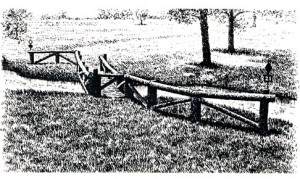 Footbridge
FootbridgeMike Huber and Gold Chip
By now the horses would most likely be tired. Their conditioning would have carried them through the first part of the course, but after several difficult combinations and then the splash, which was really five separate efforts, I felt the riders should give them a break, not hurry, let them catch their wind.
The choice here was between jumping out of water on the left side of the obstacle or, as Mike is doing here, jumping the fence first and then dealing with the water. It’s easy to jump out of water. You have nothing to worry about except a straightforward fence. But the rail on that side was higher. You could have hooked a leg coming out.
So I chose the right side, as most people did, although I wasn’t completely convinced. The problem with water on the far side of a fence was that, if your horse didn’t like the water, he may not have wanted to jump the fence. If the rail had only been a couple of inches lower on the left, I’d have decided differently.
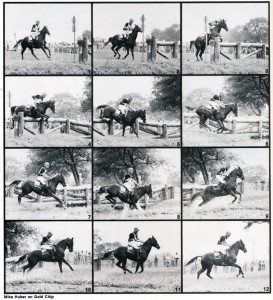 Click to view larger image. | ? Karl Leck
Click to view larger image. | ? Karl LeckKnowing that when the horses saw the water here, after what they’d just come through, they’d be suspicious, I recommended that the riders approach, as they did the pavilion and the bounce, at a good show-jumping speed, not fast, but with a lot of horse. You didn’t want so much speed that you’d flip over in the water, but you had to have a certain amount of aggressiveness or your horse would look at the water and stop.
Mike’s little mare is only 6 and not very experienced, but she’s very brave. Their approach is really positive. He’s riding strongly and she wants to go.
Maybe they’re even a little too aggressive?a hair more speed than I would have liked. But that has to do with distance. If you see your takeoff spot, you have to keep on going or you won’t meet it. Anyway everything works out quite well in the takeoff.
If there had been no water on the landing side, I bet my life the mare would be a foot over that fence. But she sees it ,and she lowers her trajectory so as to get her feet back on the ground quickly.
On the landing, she has the choice of going down through the water or jumping it. You can see her trying to figure out what she is going to do here. I like her attitude in Frame 6, her ears and her eyes. She and Mike have no doubt in their minds that they are going to get over that. It should be more or less up to the horse here whether to go through or jump and Mike is doing a good job giving her a chance to do what she wants to do.
In Frame 7, she jumps and lands a bit short in Frame 8, I think because she lost a little of her momentum. Mike gives her plenty of rein but she lands a bit deep and gets slightly stuck. In Frame 9 she pulls herself out, but she’s lost more momentum. In Frame 10?that’s the difficult stride after the water?Mike is slightly out of balance. But in Frame 11, they’re back together and going well.
This article originally appeared in the December 1978 issue of Practical Horseman magazine. A partial reprint appeared in the July 2013 issue.










